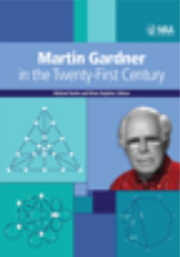Book contents
- Frontmatter
- Preface
- Contents
- I Geometry
- II Number Theory and Graph Theory
- III Flexagons and Catalan Numbers
- IV Making Things Fit
- V Further Puzzles and Games
- VI Cards and Probability
- VII Other Aspects of Martin Gardner
- 36 Against the Odds
- 37 A Modular Miracle
- 38 The Golden Ratio—A Contrary Viewpoint
- 39 Review of The Mysterious Mr. Ammann by Marjorie Senechal
- 40 Review of PopCo by Scarlett Thomas
- 41 Superstrings and Thelma
- Index
- About the Editors
39 - Review of The Mysterious Mr. Ammann by Marjorie Senechal
from VII - Other Aspects of Martin Gardner
- Frontmatter
- Preface
- Contents
- I Geometry
- II Number Theory and Graph Theory
- III Flexagons and Catalan Numbers
- IV Making Things Fit
- V Further Puzzles and Games
- VI Cards and Probability
- VII Other Aspects of Martin Gardner
- 36 Against the Odds
- 37 A Modular Miracle
- 38 The Golden Ratio—A Contrary Viewpoint
- 39 Review of The Mysterious Mr. Ammann by Marjorie Senechal
- 40 Review of PopCo by Scarlett Thomas
- 41 Superstrings and Thelma
- Index
- About the Editors
Summary
In 1975, Martin Gardner wrote in his Mathematical Games column in Scientific American about Roger Penrose's discovery of a set of tiles that do not tile the plane periodically, but do tile it nonperiodically. Gardner did not show pictures because Penrose was waiting for a patent. In response to that column, Gardner received a letter from Robert Ammann, who wrote, “I am also interested in nonperiodic tiling, and have discovered both a set of two polygons which tile the plane only nonperiodically and a set of four solids which fill space only nonperiodically.” Ammann included pictures: he had independently discovered Penrose tilings and generalized them to three dimensions. He went on to find five more sets of planar tilings, discover the general organizing principle now known as Ammann bars, and make many other contributions to the theory of nonperiodic tiling.
No one in the tiling community knew who Ammann was. He described himself as “an amateur doodler” and he declined all invitations to meetings and conferences. In 1987, Marjorie Senechal finally succeeded in tracking him down, arranging for him to meet Penrose, Donald Coxeter, and John Conway, and even getting him to speak at two conferences. After Ammann's early death from a heart attack in 1994, she learned more about his life. At age three, he was precociously brilliant. At age four, he stopped talking and withdrew into his own world. He struggled through childhood and adolescence, “off the charts intellectually but impossible emotionally.”
- Type
- Chapter
- Information
- Martin Gardner in the Twenty-First Century , pp. 285 - 286Publisher: Mathematical Association of AmericaPrint publication year: 2012



